Hack your way to happiness
Joining an invasive alien plant-clearing exercise on the mountain is a wonderful way to spend a few hours
Some background info on why we do this: Alien Clearing from Sanparks:
One of the biggest threats to the biodiversity of the Table Mountain National Park (TMNP) is the presence of alien invasive plant species. In particular, adult, woody seed-bearing alien invasive plants – such as Port Jackson, Rooikrans, Wattle, Hakea, Pine and Blue Gum – are especially threatening.
These trees have several negative impacts on the fynbos ecosystem:
They impact negatively on the hydrology of an area (i.e. interfere with waterways) and use up precious water supplies.
They destabilise riverbanks.
They are vigorous growers and out-compete indigenous species by occupying spaces where indigenous species would thrive.
They destroy the balance of habitats, impacting negatively on indigenous fauna.
In some cases their seeds lie dormant for 70 -100 years resulting in continuous and dense re-growth
They are very flammable and cause frequent, very hot fires.
READ: A Mandela Day Hack in the Hood
Alien clearing is a core part of TMNP’s biodiversity management. The alien clearing programme is undertaken in partnership between TMNP and Working for Water, an Expanded Public Works Programme implemented by the Department of Water Affairs and Forestry (DWAF) which employs between 300–350 people from surrounding communities to work in the park.
Other alien clearing initiatives are being undertaken in the indigenous Afromontane forests. There are around 360 alien plants in Newlands Forest alone, most of them invasive. These aliens are garden escapees, such as Chinese Privet and Eugenia, and pose a real threat to the natural diversity of the forests.
TMNP Mill: The Milling Project is a small project, based in Tokai, falling within the Working for Water Programme (WFW). Seen as a Value-Added industry, the Milling Team specifically mill alien tree species (e.g. gum trees) into planks which can be used by SANParks for repairing and building new boardwalks, bird hides, etc. The aim is to promote a culture of “reduce, re-use, recycle” whilst at the same time reducing fire risks on the mountain slopes. The most important objective is the relief of poverty and the development of communities through job creation.
After felling and de-branching the trees, the branches are stacked for prescribed burning. The excess material that is left over after milling the logs is used for fire wood and the sawdust can be used by the Horse stables nearby as “bedding” for the horses.
Useful Links:
SAPIA (ARC-Plant Protection Research Institute) keeps you up-to-date via an electronic newsletter with information on what aliens you need to be on the lookout for as well as updates on biodiversity control.
iSpot is an avenue for laymen to contribute (usually by uploading images) interesting sightings of animals, plants and fungi that they encounter. Any observations from the wild or your garden, from an alien to a threatened species, is welcomed. iSpot will help you to identify any unknown species.
If you would like to be a volunteer involved with alien clearing, contact Calvin Mojapelo of the People & Conservation Department on +27 (0)21 712 0527.






